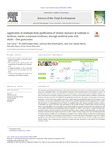Mostrar o rexistro simple do ítem
Application of residuals from purification of bivalve molluscs in Galician to facilitate marine ecosystem resiliency through artificial reefs with shells – One generation
| dc.contributor.author | Carral Couce, Luis | |
| dc.contributor.author | Lamas, M.I. | |
| dc.contributor.author | Buenhombre, José Luis Mier | |
| dc.contributor.author | Cartelle Barros, Juan José | |
| dc.contributor.author | Naya, Salvador | |
| dc.contributor.author | Tarrío-Saavedra, Javier | |
| dc.date.accessioned | 2023-01-03T12:08:25Z | |
| dc.date.available | 2023-01-03T12:08:25Z | |
| dc.date.issued | 2023-01-15 | |
| dc.identifier.citation | CARRAL, Luis, LAMAS-GALDO, M. Isabel, BUENHOMBRE, José Luis Mier, BARROS, Juan José Cartelle, NAYA, Salvador and TARRIO-SAAVEDRA, Javier, 2023. Application of residuals from purification of bivalve molluscs in Galician to facilitate marine ecosystem resiliency through artificial reefs with shells – One generation. [online]. 2023. Vol. 856, p. 159095. DOI 10.1016/j.scitotenv.2022.159095. Available from: https://www.sciencedirect.com/science/article/pii/S0048969722061940 | es_ES |
| dc.identifier.issn | 0048-9697 | |
| dc.identifier.uri | http://hdl.handle.net/2183/32290 | |
| dc.description | Financiado para publicación en acceso aberto: Universidade da Coruña/CISUG | es_ES |
| dc.description.abstract | [Abstract] The seas and oceans of the planet provide a wide range of essential resources. However, marine ecosystems are undergoing severe degradation due to the unsustainable exploitation and consumption patterns of the linear economy. On the other hand, many economic activities linked to the sea generate a large amount of waste, leading to negative impacts, such as the cost of treating or disposing of this waste. A case in point is bivalve mollusc production: a purification process is needed to avoid the risk of diseases through faecal contamination. The present work proposes an innovative procedure to convert this waste, calcium carbonate as calcite and aragonite allotropic types, into by-products. These by-products can be used to manufacture green artificial reefs, partially replacing concrete aggregates with a sustainable alternative to the geological sources of CaCO3. By installing these reefs, marine ecosystems could be created in a sustainable way and an innovative approach based on the circular economy could be taken towards protecting them. To this end, different concrete mixtures with bivalve shells are proposed. Although this study had been carried out for Galicia (NW Spain), the methodology followed could also be valid for other regions. A physicochemical characterisation of the waste from purifying the bivalves, including oysters, mussels, clams and scallops, was performed. Statistical and multi-criteria analyses were done in order to select the best dosage. Both have provided justification for using a mixture of shells with a predominance of calcite (oyster, scallop) instead of shells with a predominance of aragonite. The multi-criteria analysis served to identify the two best alternatives with dosages in which the medium aggregates were substituted with shells mainly from oysters, with a predominance of calcite. Finally, the statistical analysis played a role in estimating the compressive strength and water absorption of each mixture from the design parameter values. | es_ES |
| dc.description.sponsorship | Xunta de Galicia ; CN-10MMA003CT | es_ES |
| dc.description.sponsorship | Ministerio de Ciencia e Innovación ; PID2020-113578RB-100 | es_ES |
| dc.description.sponsorship | Xunta de Galicia ; ED431C-2020-14 | es_ES |
| dc.description.sponsorship | Xunta de Galicia ; ED431G2019/01 | es_ES |
| dc.language.iso | eng | es_ES |
| dc.publisher | Elsevier | es_ES |
| dc.relation.uri | https://doi.org/10.1016/j.scitotenv.2022.159095 | es_ES |
| dc.rights | Attribution-NonCommercial 4.0 International (CC BY-NC 4.0) | es_ES |
| dc.rights.uri | http://creativecommons.org/licenses/by-nc/3.0/es/ | * |
| dc.subject | Artificial reef (AR) | es_ES |
| dc.subject | Purification of bivalve molluscs | es_ES |
| dc.subject | Circular economy | es_ES |
| dc.subject | Sustainability | es_ES |
| dc.subject | Recycling | es_ES |
| dc.title | Application of residuals from purification of bivalve molluscs in Galician to facilitate marine ecosystem resiliency through artificial reefs with shells – One generation | es_ES |
| dc.type | info:eu-repo/semantics/article | es_ES |
| dc.rights.access | info:eu-repo/semantics/openAccess | es_ES |
| UDC.journalTitle | Science of the Total Environment | es_ES |
| UDC.volume | 856, Part 1 | es_ES |
| dc.identifier.doi | https://doi.org/10.1016/j.scitotenv.2022.159095 |
Ficheiros no ítem
Este ítem aparece na(s) seguinte(s) colección(s)
-
CIT-GEM - Artigos [21]
-
GI-SISTER - Artigos [37]
-
GI-CIM - Artigos [27]
-
GI-MODES - Artigos [143]
-
GI-GRIDP - Artigos [12]






